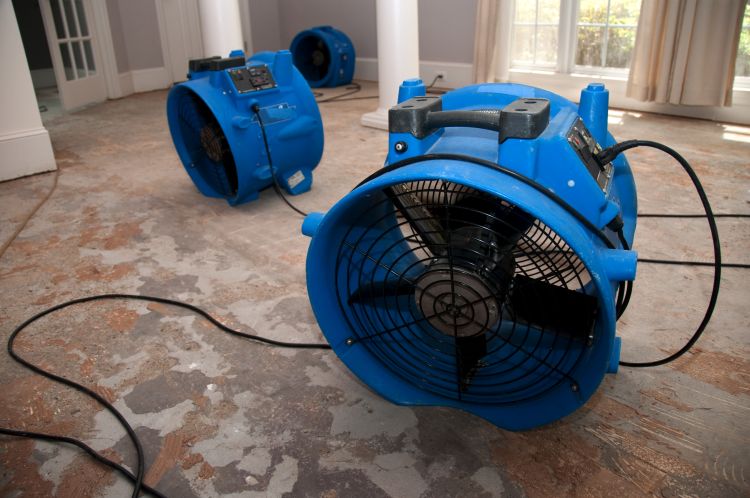Water damage is a frequent issue that homeowners face and can come from various sources such as leaks, flooding, or broken pipes. To manage the damage effectively, it is crucial to understand the distinction between water mitigation and water damage restoration. In this article, we will clarify the differences between the two processes and what you can anticipate from each one.

Water Damage Restoration
Water damage restoration is the process of repairing and restoring a water-damaged home to its original condition. It always occurs after water mitigation.
Understanding Water Damage Restoration
Water damage restoration involves fixing and restoring a home that has been damaged by water, including:
- Removing water-damaged drywall and other affected structural elements
- Pulling out and disposing of floor covering
- Replacing or restoring subfloor
- Removing and encapsulating mold growth
- Repairing or replacing windows and doors
- Fixing damaged roof
- Testing for moisture to ensure the property is completely dry
Cost of Water Damage Restoration
The cost of water damage restoration Fort Collins varies depending on the extent of the damage and the type of water event. On average, it can cost between $1,500 and $6,000 for water damage restoration services. The cost can range from as little as $200 for localized services to as much as $100,000 for large structural repairs. The cost will depend on several factors such as the size of the home, the type of water damage, and the extent of the damage.
Importance of Water Damage Restoration
Water damage restoration is a critical step in repairing and restoring a home that has been damaged by water. The restoration process helps to return the home to its pre-damaged state, making it safe and livable once again. A professional and experienced water damage restoration company will have the necessary expertise and equipment to handle the entire restoration process, from removing water-damaged materials to repairing and restoring the home to its original condition.
Choosing a Water Damage Restoration Professional
When choosing a water damage restoration professional, it is essential to select a reputable and experienced company. The company should be certified by the Institute of Inspection, Cleaning and Restoration Certification (IICRC) and should have a proven track record of successfully restoring homes from water damage. The company should use the latest techniques and equipment, including moisture meters and thermal imaging cameras, to detect hidden moisture and ensure that the home is restored to meet current building codes and standards.
Water Mitigation
Water mitigation is a crucial first step in addressing water damage, including controlling and stopping the flow of water, extracting the water, and drying out the property.
Understanding Water Mitigation
Water mitigation is a process that encompasses controlling and stopping the flow of water, assessing the damage, and taking steps to prevent further damage. This includes:
- Stabilizing the structure
- Removing any water-damaged furniture and carpeting
- Assessing the type of water damage (clear, gray, or black water)
- Disinfecting any remaining materials
- Using pumps and vacuums to extract the water
- Drying out the property with large fans
- Preventing further damage with tarps and boarding up windows
Cost of Water Mitigation
The cost of water mitigation varies depending on the extent of the damage. On average, it can cost between $1,300 and $5,200. The cost of mitigating clear water damage is typically less expensive than mitigating black water damage. The cost will depend on several factors, such as the size of the home, the type of water damage, and the extent of the damage.
Importance of Water Mitigation
Water mitigation is a critical first step in controlling and preventing further damage from a water event. Water can cause extensive harm to a home and its contents in a short period, and the longer the water sits, the more damage it will cause. Water mitigation helps to stop the flow of water, extract the water, and dry out the property to prevent further damage.
Selecting a Water Mitigation Professional
When choosing a water mitigation professional, it is important to choose a reputable and experienced company. The company should be certified by the Institute of Inspection, Cleaning and Restoration Certification (IICRC) and should have a proven track record of successfully mitigating water damage. The company should also use the latest equipment and techniques to extract the water and dry out the property.
Water Mitigation and Restoration in Action
Water mitigation and restoration are time-sensitive processes that must be handled quickly to prevent further damage. In the event of a water event, these steps should be taken:
- Contact a water mitigation and restoration professional as soon as possible.
- Stop the flow of water if possible.
- Remove any standing water and dry out the property.
- Assess the damage and determine the extent of the restoration required.
- Remove any water-damaged materials and begin the restoration process.
- Test for moisture to ensure that the home is completely dry.
- Repair and restore the home to its pre-damaged state.
Prevention is Key
The best way to avoid the need for water mitigation and restoration is to prevent water damage from occurring in the first place. Homeowners can reduce the risk of water damage by taking the following steps:
- Regularly checking pipes and appliances for leaks.
- Installing a sump pump in the basement.
- Installing a water alarm to detect leaks.
- Maintaining proper grading and drainage around the home.
- Regularly cleaning gutters and downspouts to ensure proper water flow.
Conclusion
In conclusion, water mitigation and water damage restoration are essential processes for managing and repairing water damage. Understanding the differences between the two, choosing a reputable and experienced professional, and taking steps to prevent water damage from occurring can help ensure that your home is protected from water damage.